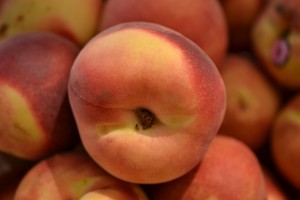 Peaches are a summer favorite, but unless you have your own peach tree you have to rely on farmers to get peaches to you. How does the commercial peach picking process work? Given that California grows 70 percent of U.S.-grown fresh peaches and 93 percent of fresh nectarines and plums, we thought we should learn. We took a Real Food Summer road trip to learn more about the life and journey of these blushing beauties.
Peaches are a summer favorite, but unless you have your own peach tree you have to rely on farmers to get peaches to you. How does the commercial peach picking process work? Given that California grows 70 percent of U.S.-grown fresh peaches and 93 percent of fresh nectarines and plums, we thought we should learn. We took a Real Food Summer road trip to learn more about the life and journey of these blushing beauties.
The Heart of California Peach Country
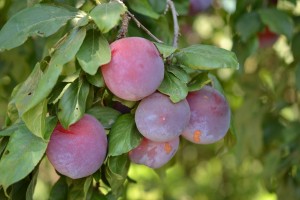 Approximately 90 percent of California peaches, plums, and nectarines grow in Fresno, Tulare, and Kern counties, in the heart of California’s Central Valley. That’s why a logical first choice for our peach picking lesson was a journey down the Fresno County Fruit Trail with friends from the California Farm Water Coalition. We visited two stone fruit farms. Friesen Family Farms of Kingsburg, CA, has its own packing facility. Hudson Farms of Sanger, CA, sends its fruit to a packing company.
Approximately 90 percent of California peaches, plums, and nectarines grow in Fresno, Tulare, and Kern counties, in the heart of California’s Central Valley. That’s why a logical first choice for our peach picking lesson was a journey down the Fresno County Fruit Trail with friends from the California Farm Water Coalition. We visited two stone fruit farms. Friesen Family Farms of Kingsburg, CA, has its own packing facility. Hudson Farms of Sanger, CA, sends its fruit to a packing company.
What Makes A ‘Standard Peach’?
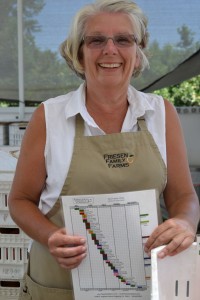
Paula Friesen holds up a chart showing the harvest periods for all of the stone fruit varieties at her farm.
The first thing to know about peaches is that there’s no such thing as “a regular peach.” Sure, there are white peaches and yellow peaches, but California grows about 200 different varieties of peaches. At the 250-acre Friesen Family Farms, we tasted several of the varieties that were in season just that week, which included the Summer Sweet White peach, the Sweet Blaze peach, the July Flame peach, and the Summer Flame peach. (And yes, each one had a distinct taste and flavor.)
Curiously, there are some varieties of stone fruit that never appear in stores. For example, the farm stand at Friesen sold an apricot called simply “Experimental Apricot.” It was a breed that wasn’t able to hold up the rigors of packing and shipping so it never made it to the market (and the apricot never got an official name).
Peach Picking in the Summer
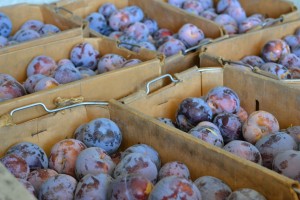 At Friesen Family Farms, workers pick the fruit (all stone fruits) by hand on a ladder in grueling 100-plus degree heat and humidity. The packing warehouse is inside an open-air building, so there’s reprieve from the blazing sun, but still, it makes for very hot work in the middle of the summer.
At Friesen Family Farms, workers pick the fruit (all stone fruits) by hand on a ladder in grueling 100-plus degree heat and humidity. The packing warehouse is inside an open-air building, so there’s reprieve from the blazing sun, but still, it makes for very hot work in the middle of the summer.
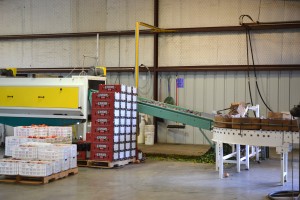 After orchard workers pick the fruit, it goes straight to the packing warehouse. (Packing needs to take place on the same day as picking). When it arrives in the warehouse, it goes through a washing/waxing machine where each piece of fruit gets a thin, protective coat of wax. (All of the fruits except apricots get “waxed.”) A group of workers then grades for quality. A #1 grade fruit (top quality) keeps going down the assembly line; a #2 grade fruit (slightly bruised or otherwise imperfect) goes to the the farm stand. All other rejected pieces of fruit slide down a chute into a waiting truck. The truck then dumps the fruit all along the trails. As the fruit decomposes, the pits help with dust control.
After orchard workers pick the fruit, it goes straight to the packing warehouse. (Packing needs to take place on the same day as picking). When it arrives in the warehouse, it goes through a washing/waxing machine where each piece of fruit gets a thin, protective coat of wax. (All of the fruits except apricots get “waxed.”) A group of workers then grades for quality. A #1 grade fruit (top quality) keeps going down the assembly line; a #2 grade fruit (slightly bruised or otherwise imperfect) goes to the the farm stand. All other rejected pieces of fruit slide down a chute into a waiting truck. The truck then dumps the fruit all along the trails. As the fruit decomposes, the pits help with dust control.
Fruit Gets Weighed and Sorted
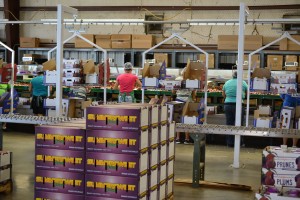 The top-quality fruit then falls into a cup on the sizer. The sizer automatically weighs each piece of fruit. Then the machine sorts them by weight and drops them off into the appropriate bin. At the bottom of the chute, a computer screen tells the packing worker which size of fruit and which variety is next. He or she can then pack the fruit in the appropriate box. The fruit boxes range from 5 to 25 pounds, and the workers pack as many as 5,000 to 7,000 boxes per day at the peak of the summer season (with an average of 2,000 to 4,000 per day).
The top-quality fruit then falls into a cup on the sizer. The sizer automatically weighs each piece of fruit. Then the machine sorts them by weight and drops them off into the appropriate bin. At the bottom of the chute, a computer screen tells the packing worker which size of fruit and which variety is next. He or she can then pack the fruit in the appropriate box. The fruit boxes range from 5 to 25 pounds, and the workers pack as many as 5,000 to 7,000 boxes per day at the peak of the summer season (with an average of 2,000 to 4,000 per day).
If you want to buy and eat fresh peaches this summer, chances are you’ll see some Friesen Family Farms peaches. These peaches go to grocery stores all over the U.S. and major chains like Costco and Wal-Mart. Want to know for sure that it came from Friesen? If you are able to look at the box, it will read “CA 1945.”
“Sink Peaches”
Over at Hudson Family Farms, we saw more varieties of peaches including a pale yellow heirloom variety known as a “water peach.” You need to eat these peaches right away – they don’t stand up to the rigors of packing and transport. If you taste them you’ll see why. Proprietor Liz Hudson tells us her family used to call them “sink peaches” – as in, you have to eat them over the sink to catch all of the juicy drips.

The peaches grown at the 180-acre Hudson Farms (other than the delicate water peaches) travel to the Wawona Packing Company. The company then freezes these peaches. The frozen peaches go into products such as peach ice cream, Jamba Juice, and frozen peach pies like Mrs. Smith’s and Marie Callender’s. (Hudson Farms sells its nectarines and plums fresh.) So if you’ve had a peach-flavored Jamba Juice or a Marie Callender’s pie, chances are you’ve enjoyed a Hudson Farms peach.
Peach Cobbler Recipe
After all of that peach picking, what’s the best way to eat a summer peach? Bake it into an old-fashioned cobbler. Liz Hudson served us some delicious fresh-baked cobbler, and she graciously shared the recipe with us:
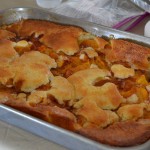
Hudson Farms Peach Cobbler
A delicious peach cobbler from Liz Hudson of Hudson Farms.
Ingredients
- 1/4 cup plus 2 tbsp butter (must be butter!)
- 1 1/4 cup sugar, divided
- 3/4 cup all-purpose flour
- 2 tsp baking powder
- 1 tsp vanilla
- dash salt
- 3/4 cup milk
- additional cinnamon and sugar (optional)
Instructions
-
Preheat oven to 350 degrees. Melt butter in a two-quart baking dish in the oven. While it is melting, combine 3/4 cup sugar, flour, baking powder and salt; add milk and vanilla and stir until mixed. Pour batter over melted butter in baking dish, but do not stir.
-
Combine peaches and remaining 1/2 cup sugar; spoon over batter. Do not stir. Sprinkle a cinnamon and sugar mixture on top if desired. Bake at 350 degrees for 60 minutes.
Many thanks again to Friesen Family Farms, Hudson Farms, the California Farm Water Coalition, and the Fresno Farm Bureau for an inside look at peach growing and packing. And remember that just about every peach you buy, whether it’s fresh from the supermarket or baked into a frozen peach pie, most likely spent some time basking in the California sunshine.

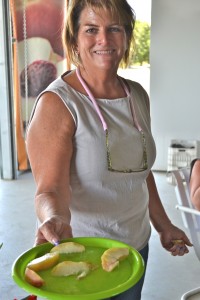
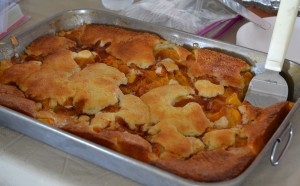
 Hi! I'm Jeanne Fratello - a writer, reporter, and food enthusiast who is on a mission to write great stories about food and where your food comes from.
Hi! I'm Jeanne Fratello - a writer, reporter, and food enthusiast who is on a mission to write great stories about food and where your food comes from.
I would have loved to join you for this, wish I wouldn’t have been out of town =) Looks like a ton of fun… and I could really go for a peach right about now.
Aw, thanks, Jamie! Next time!!!
We only eat “real food” in our house. My kids finally decided that they like peaches, so perhaps I can think of a way to make this gluten free for them!
And it’s totally peach season! I love summer fruits and our fruit bowl is full of peaches and nectarines. Oh those poor fruit pickers, picking fruit in 100º+ weather! Great post!
Love the blog and photos. Sorry I missed your visit – but glad to see you connected with some of our best Fruit ambassadors. Hope you had a great time on the Fresno County Fruit Trail. One of the best things about the Central Valley summers is the fresh fruit – lots of sun/heat makes for delicious juicy fruit.
PS – Enjoying a Friesen peach right now!
Thanks, Kristi! It was a pleasure!